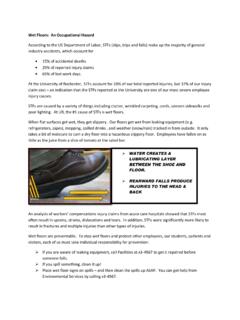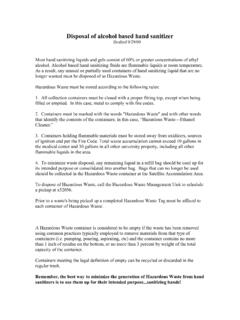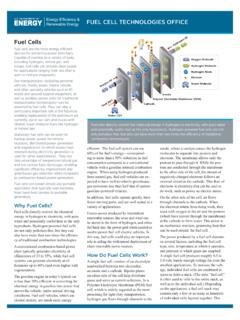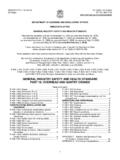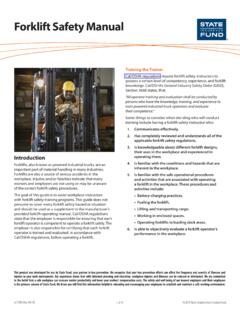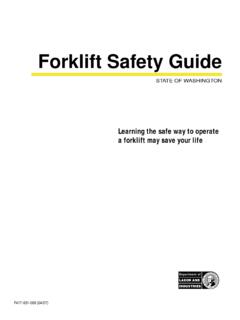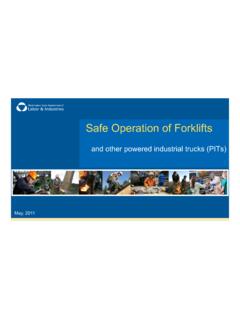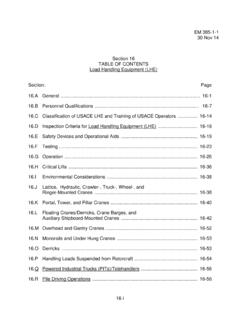Transcription of Forklift Training - General - University of Rochester
1 Forklift Training - GeneralForklift Training - GeneralOSHA (l) (a) (a)(2)(xiv) (b)(10) (d)OSHA StandardsOSHA (l) (l) (a) (a) (a)(2)(xiv) (a)(2)(xiv) (b)(10) (b)(10) (d) (d)Environmental Health & SafetyTrainingTrainingPowered industrial trucks (l)(l) Operator Training .(l)(1) Safe operation.(i) The employer shall ensure that each powered industrial truck operator is competent to operate a powered industrial truck safely, ..the employer shall ensure that each operator has successfully completed the Training required by thisparagraph (l), except as permitted by paragraph (l)(5).Powered industrial trucks (l)(l) Operator Training .(l)(1) Safe operation.(i) The employer shall ensure that each powered industrial truck operator is competent to operate a powered industrial truck safely.
2 The employer shall ensure that each operator has successfully completed the Training required by thisparagraph (l), except as permitted by paragraph (l)(5).Environmental Health & SafetyForklift driver certificationForklift driver certification The employer shall certify that each operator has been trained and evaluated as required by the standard. Certification shall include: Name of operator Date of Training Date of evaluation Identity of person(s) performing the Training or evaluation The employer shall certify that each operator has been trained and evaluated as required by the standard. Certification shall include: Name of operator Date of Training Date of evaluation Identity of person(s) performing the Training or evaluationEnvironmental Health & SafetyForklift Training contentForklift Training content Operating instructions, warnings and precautions for the types of trucks the driver will use truck controls and instrumentation Engine or motor operation Steering and maneuvering Visibility (including restrictions due to loading)
3 Fork and attachment operation Vehicle capacity Vehicle inspections, maintenance, refueling and charging of batteries Surface conditions where vehicle will be operated Composition of loads to be carried Pedestrian traffic Environmental considerations that could result in buildup of hazardous fumes or exhaust Operating instructions, warnings and precautions for the types of trucks the driver will use truck controls and instrumentation Engine or motor operation Steering and maneuvering Visibility (including restrictions due to loading) Fork and attachment operation Vehicle capacity Vehicle inspections, maintenance, refueling and charging of batteries Surface conditions where vehicle will be operated Composition of loads to be carried Pedestrian traffic Environmental considerations that could result in buildup of hazardous fumes or exhaustEnvironmental Health & SafetyScope (a), based on ANSI - (a), based on ANSI - Covers fork trucks, tractors, platform lift trucks , motorized hand trucks, and other specialized industrial trucks powered by electric motors or internal combustion engines.
4 It does not apply to compressed air or nonflammable compressed gas-operated industrial trucks, farm vehicles, nor vehicles intended primarily for earth moving or over-the-road hauling. This scope covers General industry, construction and shipyards. Covers fork trucks, tractors, platform lift trucks , motorized hand trucks, and other specialized industrial trucks powered by electric motors or internal combustion engines. It does not apply to compressed air or nonflammable compressed gas-operated industrial trucks, farm vehicles, nor vehicles intended primarily for earth moving or over-the-road hauling. This scope covers General industry, construction and Health & SafetyReasons for New StandardReasons for New Standard PITs cause approximately 100 fatalities and 36,340 serious injuries in General industry and construction annually.
5 OSHA estimates that 20 - 25% of the accidents are, at least in part, caused by inadequate Training Updated consensus standards have been published. OSHA has been petitioned to improve the requirements for industrial truck Training . Advisory Committee on Construction Safety and Health has recommended improving the standard. Resolutions were introduced in the Senate and House urging OSHA to revise its outdated standard. PITs cause approximately 100 fatalities and 36,340 serious injuries in General industry and construction annually. OSHA estimates that 20 - 25% of the accidents are, at least in part, caused by inadequate Training Updated consensus standards have been published.
6 OSHA has been petitioned to improve the requirements for industrial truck Training . Advisory Committee on Construction Safety and Health has recommended improving the standard. Resolutions were introduced in the Senate and House urging OSHA to revise its outdated Health & SafetyBackground The previous OSHA standards, while requiring operator Training , did not define the type of Training or authorization required. March 15, 1988 - Industrial truck Association (ITA) petitioned OSHA for specific Training requirements. American National Standards Institute (ANSI), 4 times, including current lift truck technology in cooperation with ASME, has revised its standard and specific Training Health & SafetyBackground (continued) March 14, 1995: OSHA published a proposed ruling adding specific Training requirements.
7 January 30, 1996, OSHA proposed a revision of the construction standards, mandating the development of an operator Training program based on the prior knowledge and skills of the trainee and requiring a periodic Health & SafetyFinal RuleFinal Rule Final rule for Powered Industrial truck Operator Training published on December 1, 1998. Effective date March 1, 1999. It applies to all industries except agricultural operations. OSHA estimates that the new rule will prevent 11 deaths and 9,422 injuries per year. Final rule for Powered Industrial truck Operator Training published on December 1, 1998. Effective date March 1, 1999. It applies to all industries except agricultural operations.
8 OSHA estimates that the new rule will prevent 11 deaths and 9,422 injuries per Health & SafetyForklift Fatalities, 1992-1996 Forklift Fatalities, 1992-19968689120951141992199319941995199 6 Environmental Health & SafetyForklift Fatalities by Age Group1992 -1996 Forklift Fatalities by Age Group1992 -19963%10%22%21%12%5%27%Under 2020 - 2425 - 3435 - 4445 - 5456 - 6465 & overSource: Bureau of Labor StatisticsEnvironmental Health & SafetyIndustries Where Powered Industrial truck Accidents OccurredSource: OSHA Fatality/Catastrophe Reports, complied by OSHA Office of Electrical/Electronic andMechanical Engineering Safety Health & SafetyWhy Forklift Training Is NecessaryWhy Forklift Training Is Necessary 100 fatalities each year 20,000 lost workday injuries annually Common injuries Hitting a pedestrian Tipping over Falling from raised forks Falling from a ladder struck with a Forklift Falling material Training reduces injuries 100 fatalities each year 20.
9 000 lost workday injuries annually Common injuries Hitting a pedestrian Tipping over Falling from raised forks Falling from a ladder struck with a Forklift Falling material Training reduces injuriesEnvironmental Health & SafetyFatalities/Injuries Potentially Averted Annually by New StandardSource: Department of Labor, OSHA, Office of Regulatory Analysis, 1997 Environmental Health & SafetyNew Std. OverviewNew Std. Overview Operators must be trained and evaluated Only drive the types of trucks on which you have been trained Operators must be trained and evaluated Only drive the types of trucks on which you have been trainedEnvironmental Health & SafetyEffective Powered Industrial truck Operator Training Program Four major areas of concern must be addressed: The General hazards that apply to the operation of all or most powered industrial trucks; The hazards associated with the operation of particular types of trucks; The hazards of workplaces generally.
10 And, The hazards of the particular workplace where the vehicle Health & SafetyBasic Forklift rulesBasic Forklift rules Don t stand or pass under raised forks Only handle stable loads within truck s rated capacity Use a safety platform to lift people Only use approved trucks in hazardous locations Don t drive up to anyone in front of a fixed object Don t stand or pass under raised forks Only handle stable loads within truck s rated capacity Use a safety platform to lift people Only use approved trucks in hazardous locations Don t drive up to anyone in front of a fixed objectEnvironmental Health & SafetyBasic Forklift rulesBasic Forklift rules Slow down, sound horn at intersections Maintain safe following distances, clearance No stunt driving, horseplay Look in direction of travel Slow down, sound horn at intersections Maintain safe following distances, clearance No stunt driving, horseplay Look in direction of travelEnvironmental Health & SafetyBasic Forklift rulesBasic Forklift rules Secure truck trailers before entering Lower forks, neutralize controls, shut off engine, and set brakes when truck is unattended Only use approved trucks in hazardous locations Don t drive up to anyone in front of a fixed object Secure truck trailers before entering Lower forks, neutralize controls, shut off engine.






